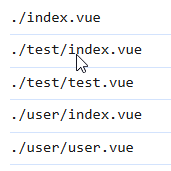vue2自动路由
...大约 2 分钟
vue2自动路由
每次在views下添加页面后,都需要去配置路由,总是手动去设置,会比较麻烦
于是研究了一下根据目录结构自动生成路由,这样在views下添加文件之后就会自动生成路由了
先查看需要的路由结构
const routes = [
{
path: '/',
component: () => import('@/layout/index.vue'),
children: [
{
path: '',
name: 'index',
component: () => import('@/views/index.vue')
}, {
path: '/test',
name: 'test',
component: () => import('@/views/test/index.vue')
},{
path: '/test/index',
name: 'test-test',
component: () => import('@/views/test/test.vue')
}
]
},
]
通过webpack的require.context
获取目录路径
const glob = require.context('@/views', true, /\.vue$/)

首先删除尾部的.vue 通过.slice(0, -4)
然后通过分割/再次拼接即可获得需要的路径
我这里判断了index的情况
const pages = glob.keys().map(item => {
const name = item.slice(0, -4)
const x = name.split('/')
const page = {}
if (x.length == 2) {
if(x[1]=='index'){
page.path = ``
page.name = 'index'
}else{
page.path = `/${x[1]}`
page.name = x[1]
}
} else {
if (x[2] == 'index') {
page.path = `/${x[1]}`
page.name = x[1]
} else {
page.path = `/${x[1]}/${x[2]}`
page.name = x[1] + '-' + x[2]
}
}
page.component = glob(item).default
return page
})
具体实现
项目目录结构
├── src
│ ├── router
│ ├── index.js
│ ├── layout
│ ├── index.vue
│ ├── views
│ ├── test
│ ├── index.vue
│ ├── test.vue
│ ├── user
│ ├── index.vue
│ ├── user.vue
│ ├── index.vue
│ ├── App.vue
│ ├── main.js
└── vue.config.js
router/index.js
import Vue from 'vue'
import VueRouter from 'vue-router'
Vue.use(VueRouter)
const glob = require.context('@/views', true, /\.vue$/)
const pages = glob.keys().map(item => {
const name = item.slice(0, -4)
const x = name.split('/')
const page = {}
if (x.length == 2) {
if(x[1]=='index'){
page.path = ``
page.name = 'index'
}else{
page.path = `/${x[1]}`
page.name = x[1]
}
} else {
if (x[2] == 'index') {
page.path = `/${x[1]}`
page.name = x[1]
} else {
page.path = `/${x[1]}/${x[2]}`
page.name = x[1] + '-' + x[2]
}
}
page.component = glob(item).default
return page
})
const routes = [
{
path: '/',
component: () => import('@/layout/index.vue'),
children: pages
}
]
const router = new VueRouter({
mode: 'history',
base: process.env.BASE_URL,
routes
})
export default router
layout/index.vue
这是只是示范 因为有一层children,所以需要一个 其他的自行修改
<template>
<div>
<div style="margin: 50px auto;">
layout
</div>
<router-view />
</div>
</template>
<script>
export default {
data(){
return{
}
},
methods:{
}
}
</script>
<style scoped>
</style>
main.js
import Vue from 'vue'
import App from './App.vue'
import router from './router'
Vue.config.productionTip = false
new Vue({
router,
render: h => h(App)
}).$mount('#app')
app.vue
<template>
<div id="app">
<router-view/>
</div>
</template>
效果图:
layout的内容一直在页面中
切换路由切换的是<router-view />









